In this article, You will read Thornthwaite Climatic Classification for UPSC IAS Exam.
Thornthwaite Climatic Classification
C. W. Thornthwaite, an American climatologist, presented his first scheme of classification of climates of North America in 1931 when he published the climatic map of North America.
Later he extended his scheme of climatic classification for world climates and presented his full scheme in 1933.
He further modified his scheme and presented the revised second scheme of classification of world climates in 1948. In his 1948 concept; gave the potential evapotranspiration concept. His scheme is complex and empirical in nature.
In 1931, his classification looked similar to Koeppen. Like Koeppen, Thornthwaite also thought that vegetation is the indicator of climate type.
Two basic features of this classification are
- Precipitation Effectiveness; (P/E, where P is the total monthly precipitation and E is the total monthly evaporation)
- Temperature Efficiency.
On the basis of these two indicators, Thornthwaite divided the world into five humidity regions.
- A: Very Humid Rain Forest
- B: Humid Forest
- C: Semi Humid Grassland
- D: Semi-Dry Steppe
- E: Dry Desert
Each region had its own special type of vegetation as shown in the table below:
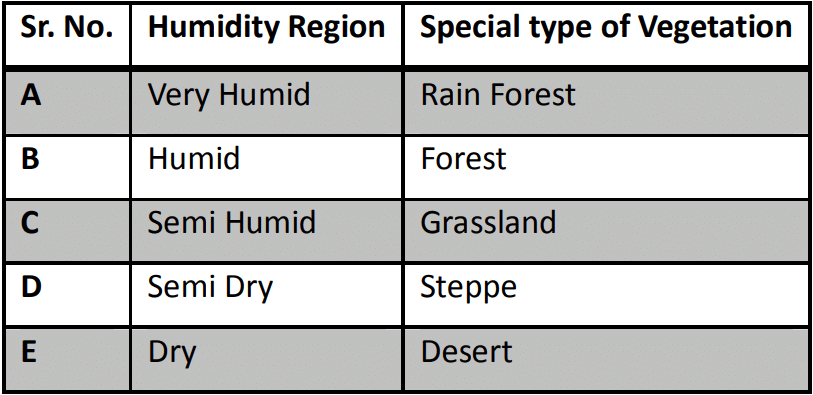
Design of Thornthwaite Climatic Classification
Thornthwaite’s design of climate classification is a combination of three letter alphabets.
- The first alphabet used in the major climatic classification is any one of the English capital letters from A to E.
- The second letter used in the climatic classification is also an English capital alphabet superscript with a dash. It denotes thermal provinces.
- The third letter in a combination of alphabets is denoted by a set of 8 small English alphabets.
Precipitation effectiveness
- Plants’ growth is not only dependent on precipitation but precipitation effectiveness.
- Precipitation effectiveness P/E ratio=total monthly precipitation/ Evapotranspiration P/E index= sum of 12 month P/E ratio.
- Based on the P/E index, Thornthwaite classified five humidity region:
- A: ( P/E index>128) – Wet-Rainforest.
- B: ( P/E Index 64 to 127) – Humid-Forest
- C: ( P/E index 32 to 63) – Subhumid-Grassland.
- D: (P/E index 16-32) – Semi Arid-Steppe
- E: (P/E index less than 16) – Arid-Desert
On the basis of precipitation effectiveness, thermal efficiency, and seasonal distribution of rainfall there may be 120 probable combinations and hence climatic types on the theoretical ground but he depicted only 32 climatic types on the world.
- On the basis of the distribution of seasonal rainfall the above types of humidity regions were further divided into the following subdivisions:
- r = Heavy rainfall in all seasons
- s = Scarcity of rainfall in the summer season
- w = Scarcity of rainfall in the winter season
- d = Scarcity of rainfall in all seasons
- Aridity index for humid climates
- Moisture deficit acute during winter = w2
- Moisture deficit acute during summer =s2
- Humidity index for arid climates
- Moisture surplus abundant during winter =s2
- Moisture surplus abundant during summer = w2

Temperature efficiency
- Temperature efficiency is calculated mean average temperature of through years.
- Based on Temperature efficiency – Thornthwaite has divided the world into six thermal provinces. They are expressed as:
- A’ — tropical: (T/E index more than 128).
- B’ — Subtropical: (T/E index 64-127).
- C’ — Temperate: (T/E index 32 – 63)
- D‘ — Taiga: (T/E index 16-31)
- E’ — Tundra: (T/E index 1-15).
- F’ — Frost: (T/E index 0).
Thornthwait was being criticized for making climatic classification complex. To make it simple, Thornthwait gave the evapotranspiration concept to derive a climatic region in 1948.
Evapotranspiration: Combined, evaporation from the soil and transpiration from vegetation is called Evapotranspiration.
The modified Thornthwaite system (1948) is based on the concept of potential evapotranspiration (Potential ET), which approximates the water use of plants with an unlimited water supply.
Though he again used previously devised three indices of precipitation effectiveness, thermal efficiency, and seasonal distribution of precipitation in his second classification but in a different way.
Instead of vegetation, as done in 1931 classification, he based his new scheme of climatic classification on the concept of potential evapotranspiration (PE).
Which is in fact an index of thermal efficiency and water loss because it represents the amount of transfer of both moisture and heat to the atmosphere from soils and vegetation (evaporation of liquid or solid water, and transpiration from living plant leaves) and thus is a function of energy received from the sun.
Index in modified method
- Aridity Index (Ia)
- Humidity Index (Ih)
- Soil Moisture Index (Im)
if: PET >Precipitation = Soil Moisture 0/-ve
if: Precipitation > PET = Soil Moisture +ve
- Moist Climate determined by Aridity Index (variability in summer and winter)
- Dry climate determined by Moisture Index
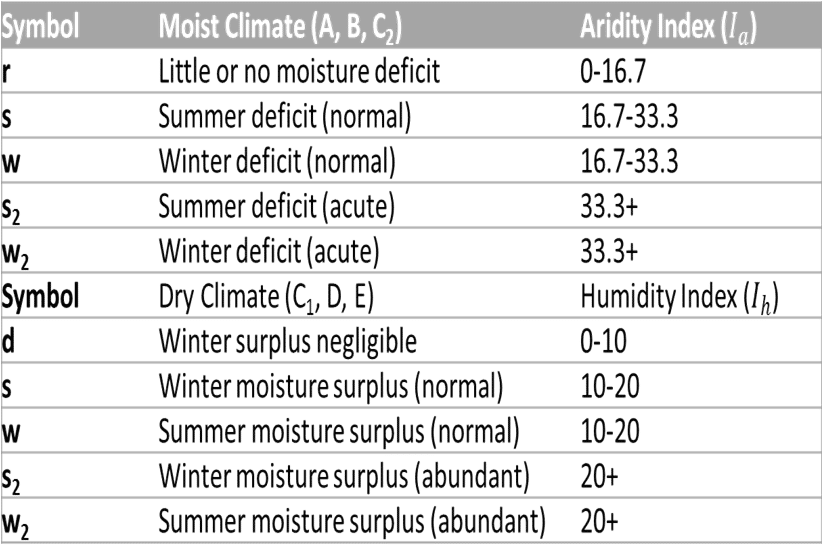
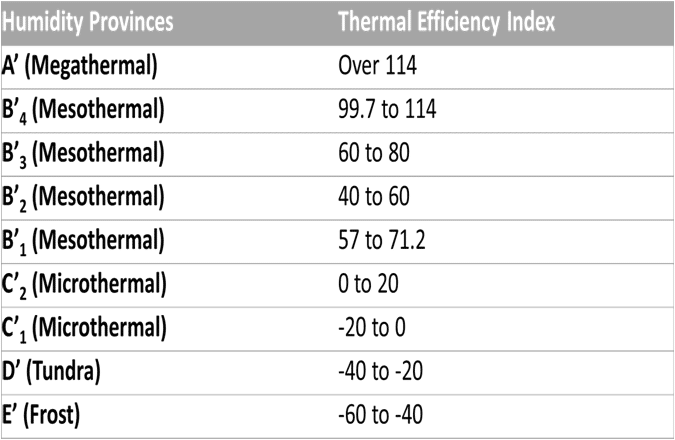
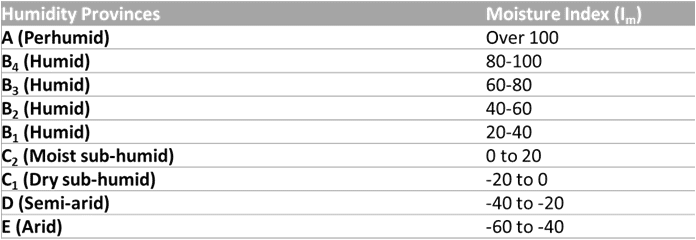
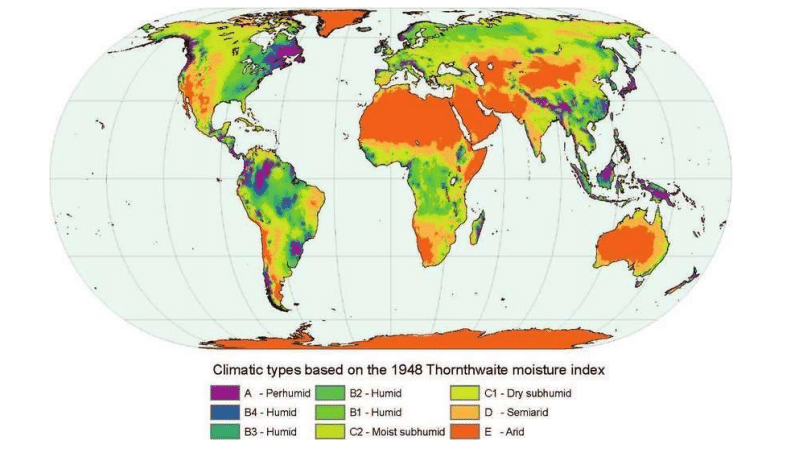
Criticism of the Thornthwaite Climatic Classification
- Thornthwaite’s classification of world climates is improved qualitatively. However, classification seems to have ignored the role of prevailing winds, relative humidity, air pressure, and air masses.
- The classification system has proved most satisfactory in the case of North America where vegetation boundaries nearly coincide with particular P/E values. But it is not satisfactory for tropical and semiarid areas.
- The calculation of soil moisture balance for different natural regions and vegetation zones poses a basic problem. Several combinations at local and regional levels increase complexity obscuring the clarity of classification.
- Availability of data for all the meteorological variables over time and space is a serious problem.
- Despite being an improved classification qualitatively, it is being less used and of limited application because of its complex nature.
- The classification of climate seems to have ignored the role of relief, the position of the sun with reference to the incidence of solar radiation on the earth.
- Current issues of global warming, climate change, and increasing incidence of extreme events do not find a place in Thornwaite’s classification of world climates.
Thornthwaite climatic division of India
The following are the climatic division of India as per the Thornthwaite concept of Evapotranspiration.
Per Humid( A) region of India:
- Western Ghats
- Most parts of the NorthEastern States
Humid(B) region of India:
- Adjoining region of the Perhumid region
Moist Sub Humid(C1) climatic region
- Narrow belt Adjoining region of the humid region of Western Ghats.
- Eastern India comprises of West Bengal and Orissa
Dry Sub Humid(C2) regions:
- Northern Narrow belt of the Ganga basin.
- Part of Uttar Pradesh, Bihar, MP, Chhattisgarh, Jharkhand
- Western Maharastra and Southern Gujarat
Semi-Arid(D) climatic region:
- Part of Punjab and Haryana
- Eastern part of Rajasthan, Maharashtra, Karnataka, Lenangna
- Western Pat of Tamilnadu.
Arid climatic( E) region of India:
- Western Rajasthan
- Western Himalayan
- Rainshadow zone of western Ghats